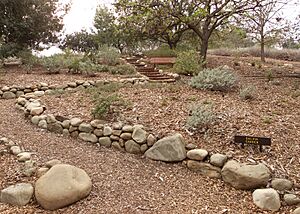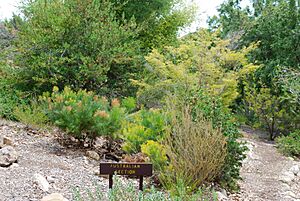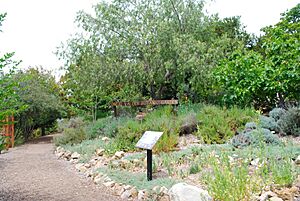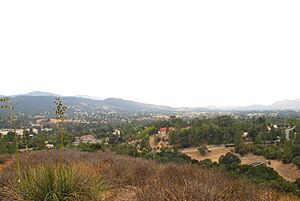Conejo Valley Botanic Garden facts for kids
Quick facts for kids Conejo Valley Botanic Garden |
|
|---|---|
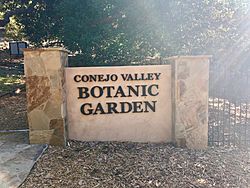
Sign by entrance.
|
|
| Lua error in Module:Location_map at line 420: attempt to index field 'wikibase' (a nil value). | |
| Type | Botanical garden |
| Location | Thousand Oaks, California, United States |
| Area | 33.6 acres (13.6 ha) |
| Operated by | Conejo Valley Botanic Garden |
| Status | Open |
| Website | www.conejogarden.org |
The Conejo Valley Botanic Garden is a special place in Thousand Oaks, California. It's like a big outdoor museum for plants! You can find it next to the Conejo Valley Community Garden. It's also right across the street from Tarantula Hill, which is the highest point in Thousand Oaks.
This garden helps people learn what kinds of plants grow best in the Conejo Valley. It covers about 33 acres (13.6 hectares) and has many different types of plants. You'll see plants that are native to the area, plants that don't need much water, and lots of oak trees. It's also home to local wildlife.
A fun part of the garden is the Kids' Adventure Garden, which opened in 2003. While the main garden is open most days, the Kids' Adventure Garden and plant sales are usually only open on Sundays. The best part? It's completely free to visit!
You can enter the garden at 400 West Gainsborough Road. You can also get there from Conejo Community Park. The land for the garden was first bought in 1973, and the first parts of the garden started growing in 1976. A non-profit group called Conejo Valley Botanic Garden, Inc. takes care of it.
Contents
What is the Conejo Valley Botanic Garden?
The garden is like a special plant sanctuary on a hill. It looks out over the beautiful Conejo Valley. On this hill, there are 15 different themed gardens. You can also find many hiking trails that connect to other paths. These paths lead to amazing views from the top of the hill.
As you walk the garden's paths, you'll see fruit trees, desert plants, native plants, and even a butterfly garden. There's also a 1-mile (1.6 km) Nature Trail that follows a creek. This trail goes down into a shady canyon filled with willow and oak trees. The garden also has a special bird habitat. This area helps provide food and shelter for birds and other animals.
How is the Garden Managed?
The Conejo Valley Botanic Garden is run by a non-profit group. They have a long-term agreement with the Conejo Recreation and Park District (CRPD). This agreement started in 1973 and lasts for fifty years. The garden only pays $1 a year in rent!
One important rule of this agreement is that the garden cannot charge money for people to enter. This means it's always free for everyone to enjoy. The garden does not get money from the government. It depends completely on donations from people who want to support it.
Explore the Specialty Gardens
The Conejo Valley Botanic Garden has 15 unique gardens. Each one is special and shows off different types of plants. Here are some of the amazing gardens you can explore:
- The Native Plant Garden and Native Meadow
- This garden features plants that naturally grow in California. You'll see shrubs, flowers, and trees.
- Look for the Santa Cruz Island Ironwood and California holly. California holly even gave Hollywood its name!
- You can also find a Coast redwood here. This is one of the world's tallest tree species.
- There's also a Giant sequoia redwood, which is the biggest tree species in the world.
- Lillian’s Meadow
- This area shows off plants that need very little water to grow.
- The Penstemon collection has colorful flowers all year long.
- It's a great example of how to create a beautiful garden with low-maintenance plants.
- The Salvia Garden
- This garden is full of Salvia plants, which also don't need much water.
- You can see many of the world's 750 Salvia species here. Ten of them are native to California.
- These Salvias come in many colors, shapes, and smells.
- The Butterfly Garden
- This garden is designed to attract butterflies and caterpillars.
- It has plants that provide nectar and food for them.
- You might see Monarchs, Western Tiger Swallowtails, Anise Swallowtails, and Painted Ladies.
- The Mediterranean Garden
- This garden has plants from five different countries.
- These countries all have a climate similar to the Mediterranean climate.
- The Herb Garden
- This garden has a large collection of herbs.
- You'll find herbs used for cooking, medicine, and even tea.
- There's also a special section with "legendary herbs."
- The Bird Habitat
- This area provides water and food for birds all year.
- It attracts both local birds and birds that migrate through the area.
- You might spot oak titmouses, mourning doves, Western scrub-jays, and northern mockingbirds.
- The Australian Garden
- This garden features many plants from Australia.
- You can see trees like the Red Flowering Gum and the Illawarra Flame Tree.
- There are also colorful plants like the Red and Green Kangaroo Paw.
- The Desert Garden
- Located near the top of the hill, this garden has desert trees and succulents.
- You'll see cacti, euphorbias, and aloes.
- Some plants are from Southern California, while others are from Mexico and South Africa.
- Look for the tall Barbary fig plant, which can be 7-8 feet tall!
- The Tranquility Garden
- This garden is designed in the style of a Japanese garden.
- It features beautiful California native plants. It was created in 1997.
- The Rare Fruit Orchard
- This orchard has a huge variety of fruit trees.
- It was planted by the California Rare Fruit Growers group.
- There are 130 trees, with 40 different types of fruit from 35 countries!
- You might see Nectarine Panamint, Black Mulberry, and Strawberry Guava.
- Sage Hill
- This hill is home to over one hundred native plant species.
- From the top, you get amazing views of the entire Conejo Valley.
- You can see Thousand Oaks, Newbury Park, the Simi Hills, and the Santa Monica Mountains.
- Kids’ Adventure Garden
- This is a super fun area for younger visitors.
- It has a tree house, a zoo garden, and even dinosaur topiaries (plants shaped like dinosaurs)!
- There are also fun paths to explore and access to the creek.
Trail of Trees
The Trail of Trees is a path that has 72 different trees. There are 50 different kinds of trees in total! Each tree has a label that tells you its name, where it's from, and when it was planted. You can see trees like the Golden Trumpet Tree from Brazil and the Tulip tree.
Garden Trails
There are many trails throughout the gardens. The Little Loop Trail goes above the creek and through a Chaparral area. The longer 1-mile (1.6 km) Nature Trail follows the creek. It goes down into a shady canyon filled with oak trees. After about a quarter-mile, you'll find steep wooden steps that lead down into the canyon. You can explore the creek-bed for about half a mile before the trail climbs back up to the main garden.
See also
 In Spanish: Jardín botánico de Conejo Valley para niños
In Spanish: Jardín botánico de Conejo Valley para niños


